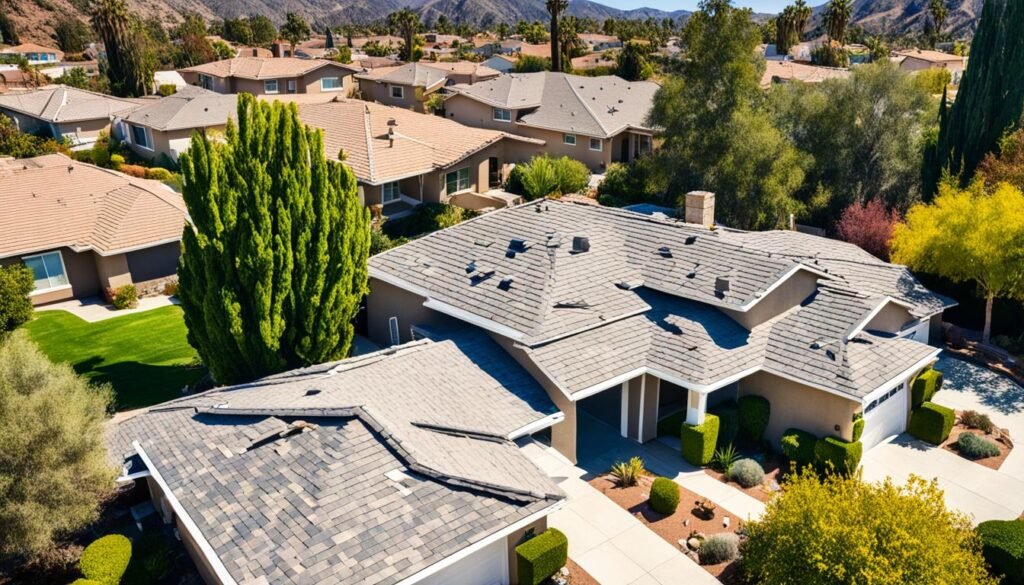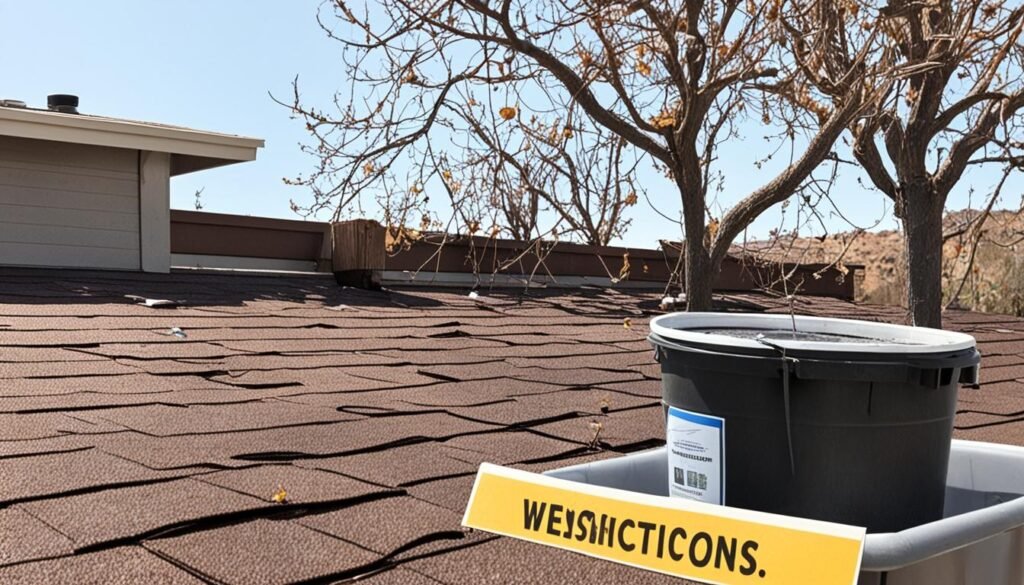Southern California is deep in one of its worst droughts ever. This lack of water is causing big problems for homeowners, especially with their roofs. Roofs are drying out, getting brittle, and are more likely to get damaged.
We’ll share how the drought affects roofs in Southern California and offer tips to deal with it. You’ll learn which materials work best in dry conditions and how to keep your roof in top shape. This info will help you safeguard your home and make your roof last longer, even with little water around.
Key Takeaways:
- Southern California is facing one of the most severe droughts in its history.
- Prolonged dry spells can cause roofing materials to dry out, become brittle, and increase the risk of damage.
- Regular roof inspections and proactive maintenance are crucial in protecting homes in water-stricken areas.
- Choosing drought-resistant materials like metal, tile, and certain composites can help mitigate the impact of the dry conditions on roofs.
- Fire risk increases in drought conditions, highlighting the importance of prioritizing fire-resistant roofing materials.
The Role of Moisture in Roof Maintenance
Roofs balance wet and dry conditions to last longer and stay strong. But, Southern California’s long drought disrupts this balance. This challenges homeowners. The air and soil’s dryness can hurt roofing materials, making them damage-prone.
During droughts, roofing materials can become brittle. They are more likely to crack, warp, or take other damage. If not cared for properly, these problems can worsen, causing expensive roof repairs.
To lessen drought’s effects on roofs, choose drought-resistant materials. Metals, tiles, and some composites can handle drought well. They don’t dry out or become brittle easily.
Drought-resistant materials are not only durable. They keep the roof’s structure safe from leaks and weather damage. They can also reflect sunlight, making your home cooler and saving energy.
The Benefits of Drought-Resistant Roofing Materials
- Increased Longevity: Materials fighting off drought help your roof last longer in Southern California.
- Reduced Maintenance: With damage-resistant materials, roof repairs become less frequent and cheaper.
- Energy Efficiency: Reflective roofing materials cut down on heat transfer. This lowers the need for cooling, saving energy.
- Aesthetic Appeal: Drought-resistant materials like tile and metal make your home look better. They add to its value, too.
In summary, picking the right materials for your roof is vital during Southern California’s drought. These choices boost durability, cut down on upkeep, save energy, and beautify your home. Investing in suitable roofing materials helps your home face drought conditions well.
Increased Fire Risk and Roofing Safety
Drought conditions make roofs more at risk of catching fire and less safe for houses. With less water around, dry roofing materials can easily become fuel for fires. To keep your home safe and reduce fire risks, it’s important to choose fire-resistant roofing materials and follow best practices in areas with little water.
Metal, slate, and some composite materials are good choices for houses in areas often hit by droughts. These materials last a long time and can handle the effects of dry conditions well. They not only resist fire but also protect against extreme weather, meaning less repair and replacement work.
“Choosing the right roofing materials is essential in water-stricken areas. Fire resistance should be a top consideration to safeguard your home and belongings.” – Jake Thompson, Roofing Expert
Best Roofing Practices in Water-Stricken Areas
To protect your home during a drought, it’s important to follow some key roofing practices:
- Regular Roof Inspections: Have your roof checked regularly to spot damage from the dry weather early. This lets you fix problems quickly before they get worse.
- Proactive Maintenance: Take steps early to keep your roof in good shape. Fix cracks, warping, or other issues as soon as you see them.
- Adequate Ventilation: Make sure your attic is well-ventilated to avoid too much heat building up. Good airflow keeps the temperature steady and lessens stress on your roof.
- Effective Insulation: Having the right insulation protects your roof by keeping temperatures stable. This stops materials from shrinking or expanding too much with the weather changes.
By using fire-resistant materials and keeping up with best roofing practices, you can lessen the effects of drought on the roofing industry and keep your home safe from fire dangers. Keeping your roof in good condition is key to making sure your house stays safe and strong in areas with little water.

The Importance of Regular Roof Inspections
Regular roof inspections are crucial in places like Southern California. They help find early damage like cracks and warping due to dry weather. Catching these problems early stops them from getting worse.
Inspecting your roof twice a year helps you tackle issues quickly. This is important in dealing with Southern California’s dry conditions. These checks help protect your roof and make it last longer.
A professional will check your roof’s condition during an inspection. They look for wear, water damage, and leaks. They also check for areas that might get worse because of the drought.
An early roof inspection lets you fix small issues early. This saves money and helps your roof last longer.
Regular inspections keep your roof in top shape despite drought challenges. They prevent big repair costs and give you peace of mind. Knowing your roof can handle dry weather is comforting.
Benefits of Regular Roof Inspections:
- Prompt identification and repair of minor issues
- Protection against further damage and costly repairs
- Prolonged lifespan of your roofing system
- Enhanced roof performance and resilience
- Preservation of your home’s structural integrity
If you want to keep your roof strong in drought areas, get it inspected. Contact a roofing expert today to learn more or to schedule an inspection. Being proactive is key for your roof’s durability and safety.

Selecting the Right Roofing Materials
In Southern California, droughts can really affect roofs. So, picking the right roofing materials is key. With the area facing long dry periods, it’s crucial to choose materials that do well in dry settings. They should also be tough against the drought’s harsh impacts.
Metal roofs are a top choice here. They’re very tough and resist the dryness well. They stay strong during long dry spells, keeping roofs safe for a long time.
Tile roofs are also a great pick for fighting drought. People have used tiles for hundreds of years because they last long and are very strong. They keep homes safe from the dry, Southern California weather.
Composite roofing is becoming popular too. These materials look like traditional ones like wood or slate but are way tougher. They’re made to handle dry conditions without losing their good looks or performance.
Also, these roofing choices help protect against fire risks, which go up during droughts. A fire-resistant roof can really help keep your home and loved ones safe.
Benefits of Selecting the Right Roofing Materials:
- Durability and longevity
- Resistance to the effects of drought
- Enhanced protection against potential fire hazards
Choosing the right materials ensures your roof stays in top shape, even in tough drought conditions in Southern California. These materials last long, resist dryness, and boost your home’s safety.
| Roofing Material | Benefits |
|---|---|
| Metal | Durability, moisture resistance, fire resistance |
| Tile | Durability, moisture resistance, fire resistance |
| Composite | Durability, moisture resistance, fire resistance, aesthetic appeal |
Effective Insulation and Ventilation
In water-stricken areas, keeping your roof in top shape is important. Proper insulation and ventilation are key. Insulation helps control your roof’s temperature and reduces stress on materials. This is vital in places like Southern California, where the heat can damage your roof. With good insulation, you can lessen the risks that come with dry conditions.
Having the right ventilation is just as important for your roof. It keeps heat from building up, which could make the roofing materials dry and brittle. A consistent flow of air can make your roof last longer and prevent damage from water scarcity.
If you’re dealing with insulation and ventilation, expert advice is crucial. Roofing professionals know the best materials and methods for areas lacking water. By investing in quality insulation and ventilation, you’re not just protecting your roof. You’re also making your home more energy-efficient.
Benefits of Effective Insulation and Ventilation:
1. Temperature regulation: Proper insulation keeps your home’s temperature steady. It eases the pressure on your roof during extreme weather.
2. Energy efficiency: With good insulation and ventilation, your home uses less energy. This cuts down on the need for a lot of heating or cooling.
3. Mold prevention: The right airflow and moisture control stop mold and mildew from growing. This helps keep your home’s air healthy.
4. Extended roof lifespan: Insulation and ventilation can fight the effects of water shortage on your roof. They help your roof last longer and save you money on repairs or replacements.
| Insulation Materials | Benefits |
|---|---|
| Fiberglass | Excellent thermal performance, non-combustible, readily available. |
| Spray Foam | Seamless installation, superior insulation properties, effectively seals air leaks. |
| Cellulose | Environmentally friendly, good soundproofing qualities, resistant to mold and pests. |
Conclusion
In Southern California, the drought brings big challenges for roofs. To deal with this, it’s important to check your roof often. You should also choose materials that work well in dry weather, and make sure your roof is insulated and ventilated right. This helps keep your home safe and makes your roof last longer in these dry areas. Because water is scarce, knowing the latest in roofing is essential to deal with the climate changes.
With the drought, checking your roof regularly is crucial. This helps find any damage early, before it gets worse. By fixing problems right away, you can beat the drought’s challenges. This stops more damage to your roof.
Picking the right roofing materials is a big part of managing the drought. Go for materials like metal, tile, or some composites. These choices are tough and can handle the dry conditions well. They also help protect your home from fire risks, which go up during a drought.
